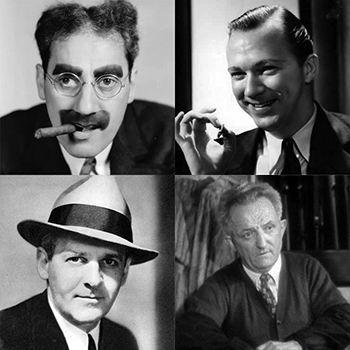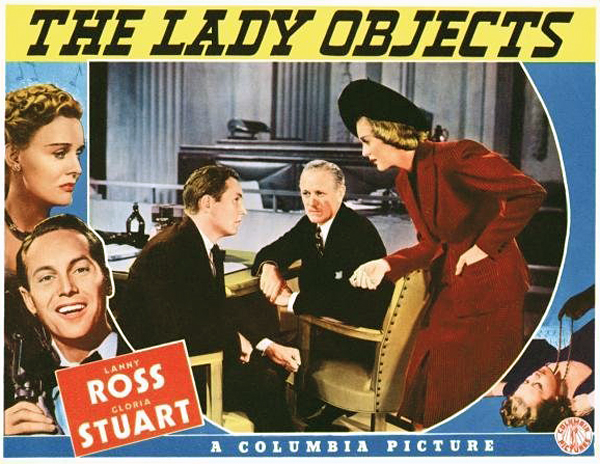We love the rapid-fire repartee and lovably shady characters that will forever be associated with Lee Tracy, born 122 years ago today. Tracy’s one of the few actors whose involvement in a picture is sufficient to convince us to watch. Show us his name in the credits, and we’re on board, no questions asked.
Tag: Lee Tracy
In Search of the Mysterious Mr. Moskowitz
 One of the joys of being an old-movie buff is when an actor in a bit part sparks your interest and you start to do a little research on him or her, which causes you to tumble down a rabbit hole of odd facts and coincidences. Sometimes one finds unlikely connections between that unfamiliar performer and some much bigger names—such as when, say, Groucho Marx, Lee Tracy, and Walter Winchell have a connection to…Milton Wallace?
One of the joys of being an old-movie buff is when an actor in a bit part sparks your interest and you start to do a little research on him or her, which causes you to tumble down a rabbit hole of odd facts and coincidences. Sometimes one finds unlikely connections between that unfamiliar performer and some much bigger names—such as when, say, Groucho Marx, Lee Tracy, and Walter Winchell have a connection to…Milton Wallace?
We recently attended a screening of Blessed Event (1932), a classic precode comedy in which Lee Tracy plays a character that was obviously inspired by gossip columnist Walter Winchell, who was all the rage back then.
We were especially excited to attend the screening, as we had been informed that some footage that had long since been excised from the picture had been restored. Reportedly, it had been there all along, but only in the print that belonged to the Library of Congress. Virtually no one knew about it till Bruce Goldstein, director of repertory programming at NYC’s Film Forum, screened the print at the TCM film festival and realized what a find he’d uncovered.
For those not familiar with Winchell, we’ll catch you up just a bit: A former vaudevillian, he turned to a scandal-mongering form of journalism when his performing career wound down. His popular newspaper column was syndicated and he had a huge following on national radio, too. He was known for coining any number of phrases still used today, including the above-cited “blessed event” used to signal the pending birth of a baby (the guardians of broadcasting decency in those days were convinced that American ears were too tender for that oh-so-coarse term “pregnant”).
Winchell’s broadcasts included remotely broadcast performances by bands and singers around the country, and right before switching to those remote locations, he would blow a siren whistle and say, “Okay, America!”
In the film, as the title suggests, Tracy’s Winchell-esque character relies on the same “blessed event” catchphrase that Winchell used. But in the restored scene, a short, middle-aged, somewhat stereotypical (though not, in our opinion, disparagingly so) Jewish man, played by one Milton Wallace, shows up at the newspaper office to give Tracy a “blessed event” tip: He, Mr. Moskowitz, and his wife are soon going to have their seventh child and he thinks maybe Tracy would want to put that into his column.
Flirting with the Past
Last night we watched The Lady Objects (1938), a strange and kind of silly drama/musical (drusical?) that finds Gloria Stuart, adorable as ever, playing a hotshot lawyer whose husband (Lanny Ross), a former All-American halfback, a world-class tenor and a hopeful young architect (quite the trifecta, that), resents her success and the demands it places on her time.

As we said, kind of silly, but entertaining enough, since we get a special kick out of watching any picture that features Ms. Stuart. We were pleased to do a telephone interview with her some years ago when her memoir was published, and we’ll admit to being not a little proud that when we got to meet her in person a few weeks later at her book party in NYC, she flirted with us just the slightest bit. Nothing overt, nothing untoward, but in a room filled almost entirely with the young women of the publishing industry, we stood out, it seems—a young(ish—we were 41 at the time) man who was thrilled to dote on Ms. Stuart, bringing her food and drink, asking her questions about her movie career back in the 1930s and generally behaving in starstruck fashion.
So whenever we see her looking so fetching on the screen, we can’t help but think, That gorgeous movie star once flirted with us, an actress who might have once flirted with Humphrey Bogart, The Marx Brothers, James Cagney, Lee Tracy, Melvyn Douglas, Boris Karloff, Ralph Bellamy, Pat O’Brien, Eddie Cantor, John Boles, Claude Rains, Lionel Atwell, Frank Morgan, Brian Donlevy, Warner Baxter, Dick Powell, Frank McHugh, Don Ameche, Lyle Talbot, George Sanders, Walter Pidgeon, Jack Oakie, and Richard Dix. In any case, she appeared in pictures with each of them (except Bogart and the Marx Brothers, whom she knew socially).
Yes, our brief encounter with Ms. Stuart came more than a half-century after those hypothetical Hollywood flirtations—she was 89 at the time—but if she batted her eyelashes at even one-tenth of her aforementioned costars back in the day, we’d have to say we’re in pretty good company!
Goodbye to another glorious gal: Gloria Stuart
We just learned of the passing yesterday of the wonderful Gloria Stuart. Stuart, who turned 100 on July 5 of this year, lived a nice, long life, of course, but we’re feeling blue nonetheless.
As some regular readers will recall, we were fortunate enough to interview Ms. Stuart eleven years ago on the occasion of the publication of her memoir, I Just Kept Hoping [you can read the interview here], and we found her utterly delightful. She was, at age 89, as witty and as sharp as one could hope to be at that age. She was also charming and engaging and not a little flirty, and we have harbored a little crush on her ever since.
Ms. Stuart had an impressive, if brief, Hollywood career in the 1930s, acting opposite the likes of Claude Rains, James Cagney, Nancy Carroll, Walter Pidgeon, Lee Tracy, Pat O’Brien, Melvyn Douglas, Dick Powell and many others, and she was friends with many other luminaries, Humphrey Bogart and the Marx Brothers among them. And we were pleased to learn that she had gotten a kick out of the career resurgence she experienced late in life.
Screen Play magazine once named Ms. Stuart one of the 10 most beautiful women in Hollywood, and we think that honor still holds today, even all those beautiful women later. But as Aljean Harmetz and Robert Berkvist wrote in an obituary that appeared in The New York Times, Stuart was “more than a pretty face. She was a founding member of the Screen Actors Guild and helped found the Hollywood Anti-Nazi League, an early antifascist organization.”
She also undertook a career as an artist, teaching herself to paint. Her first one-woman show was at NYC’s Hammer Galleries in 1961. Beginning in the 1980s, she began a new career at a printer, designing hand-printed artists’ books, even organizing her own imprint, Imprenta Glorias.
What a gal.
We’ll remain ever grateful for our brief encounters with Ms. Stuart, and we sincerely hope and pray that she will rest in peace.
     |

